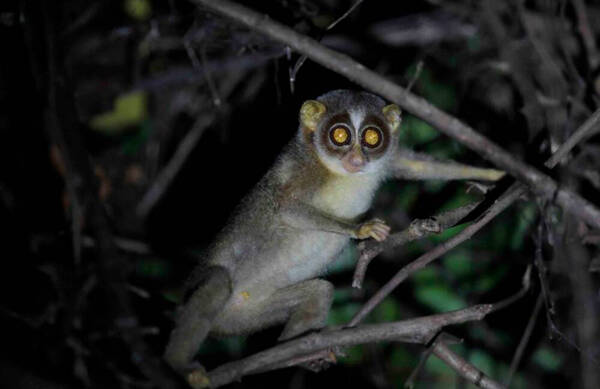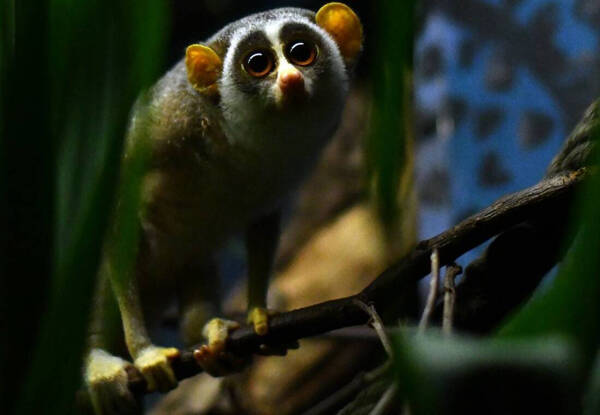Loris lydekkerianus
IUCN
LCBasic Information
Scientific classification
- name:Loris lydekkerianus
- Scientific Name:Loris lydekkerianus,Gray Slender Loris、 Grey Slender Loris、 Highland Slender Loris
- Outline:Primates
- Family:Loris
Vital signs
- length:23.4-24.1cm
- Weight:180-290g
- lifetime:About 12 years
Feature
The index fingers on the hands and feet are shorter than the other fingers
Distribution and Habitat
Gray loris are found in southern India and central, north-central and east-central Sri Lanka.
Gray loris live in many environments including dry forests, moist forests, montane forests, plantations, rainforests and shrublands of secondary forests. In these habitats, ideal trees are mainly found for climbing, foraging and mating. They live in many ecoregions including wetlands, low arid areas and low suburban areas.
Appearance
The grey slow loris weighs 180-290 grams for males and 180-275 grams for females. The body length is 23.4-24.1 cm. The fur on the upper body is grey or reddish with darker inner stripes and white on the ventral side. The eyes facing forward are large and closely set together, while the muzzle is small and pointed. There are many distinctive markings, with eyelid spots, black hair in front of the ears, and a white edge between the eyelid spots and the hair in front of the ears. The hands are small, the eyes are large, the nose is narrow, the body is very slender, and the limbs are long. The index finger on the hands and feet is shorter than the other fingers, which helps them grasp branches. There is no tail.
There are 5 subspecies: Highland subspecies, Nominate subspecies, Malabar subspecies, Sri Lanka North subspecies and Uva Province subspecies. These different subspecies differ in geographical location, fur color and body size. The Nominate subspecies is grey in color, with narro
Details
Gray Slender Loris (scientific name: Loris lydekkerianus) has five subspecies. Gray Slender Loris was once classified as a subspecies of Loris tardigradus, "Loris tardigradus lydekkerianus". In 2001, this classification was updated based on behavioral, geographical and morphological data. Gray Slender Loris is considered to be a species living in India and Sri Lanka, while "Loris tardigradus" is a species "Red Slender Loris" that is only distributed in Sri Lanka.

The range of adult gray slow lorises males is 2.36-3.6 hectares, with a core area of 0.37 hectares. The range of adult females is 1.12-1.59 hectares, with a core area of 0.15 hectares. The average family area of juvenile males is 1.17 hectares. Young gray lorises remain in their mother's home range until 10 months of age. Adult females have little copulatory overlap within their home ranges, while males have greater copulatory overlap. Any overlap within the sexes' ranges is limited to the outer range areas, with the core area remaining exclusive to one individual. Range overlap between the sexes is common and may include the core area. A male's home range may overlap with the home ranges of multiple females. The average density of gray lorises within their range is 2.4 individuals per square kilometer.
Gray lorises are nocturnal. Other species in the family Loris are almost entirely solitary, but gray and red lorises are unique in that they engage in regular social interactions. During the day, gray lorises almost always sleep in social groups of 2-7 individuals, most commonly consisting of an adult female, her offspring, and a few adult or mature males. The location and composition of these sleeping groups are generally constant. The sleeping site is usually located in the center of the home range of the primary female. Sleeping sites are often located in the tangled branches of cacti or trees. Slow lorises that sleep together often form a "sleeping ball" congregation in which the lorises entwine their limbs. At dusk, members of the sleeping group wake each other and groom, and grooming occurs between lorises of all ages and sexes. Behavioral data on sleep site composition and home range patterns support the hypothesis that red lorises have a polyandrous social system. During nocturnal foraging, gray lorises are usually solitary, although friendly foraging pairs have been observed. Males and adult males frequently visit resting infants at night. Typically, social interactions occur between adult males and females, and between adult lorises and juveniles, but rarely between adult lorises of the same sex. The species spends approximately 45% of its time engaged in inactive behaviors such as sitting, vigilantly watching, resting, and sleeping. The rest of the time is spent partly foraging or traveling, and a small amount of time is spent grooming. The most common positional behaviors are sitting and limb movements. The generally slow speed and silent movements protect the species from detection by predators that rely on visual or auditory cues. Therefore, when moving on open ground between discontinuous woods, particularly slow movements are used. Slow movement strategies also facilitate food acquisition. Especially slow movements are used immediately before catching fast-moving insect prey.

Unlike most members of the loris family, the gray loris is relatively gregarious. The species maintains social networks and makes frequent loud calls throughout the night. Loud calls are also used when potential predators are detected, during breeding, and during infant care. Males interested in females in estrus will vocalize more frequently when following them. Male-female competition also includes complex growls, high calls, and whistles. Females also make the same calls when chasing unwanted suitors. In addition, infants in anchorage will make a "zic" sound about thirty minutes before dawn to alert their mothers of their location. Urinating is another important form of communication, and the species uses rhythmic urination and urine flushing as a method of olfactory marking. Urine flushing has also been observed as a stress response. This olfactory behavior is used in social communication. Gray lorises have acute low-light vision due to their nocturnal activity and mainly detect prey by sight and smell.
Gray lorises eat almost entirely insects, with more than half of their diet consisting of ants and termites. They also consume a large number of other arthropods, including beetles and orthoptera, spiders, mollusks, and occasionally small vertebrates. Many prey items contain toxic chemicals. The consumption of toxic substances is accompanied by elaborate behavioral habits, including sneezing, head shaking, sucking hands and feet, and washing urine. Prey is detected mainly by vision and smell. Common hunting behaviors involve visual or olfactory detection, ear retraction, obvious sniffing, and a very slow approach. The habit is to hold a fixed substrate with one hand and hover the other hand near the prey, then quickly fly forward and suddenly burst to grab the prey. Sometimes, these gray lorises will capture prey with both hands, or swallow the prey directly with their mouths. They let termites crawl onto their saliva-coated hands, trap them in the saliva, and then lick them off. In addition, population density is positively correlated with insect density.
Gray lorises have a variety of mating systems. Females mate with multiple males during one estrus cycle and can mate with multiple males continuously. Males mate with multiple females throughout the year. The female estrus cycle lasts 24 hours, and the gestation period is about 165 days. The inter-birth interval lasts about 7 months, and females can produce 4 pups per year. This relatively high reproductive potential may be due to the allocation of resources by males and the high-energy milk provided by the mother. The mating behavior of gray slow lorises is highly social. An estrous female is chased by multiple males at a time. Males show their interest in estrous females by increasing the frequency of grooming, emitting more frequent vocalizations, and following the females. Males follow females on foraging trips for long periods of time, ranging from one hour to tens of hours. During this time, females can stop trailing males with their arms. Competition can occur between males following the same female. These confrontations involve vocalizations such as growling, hissing, and whistling. Male competition can also be physically violent, involving chasing and scrambling. Usually, the most successful male competitor is awarded the female's mating privileges. If the female allows copulation, copulation occurs with the female hanging from a horizontal branch. A single copulation lasts 3-11 minutes. A complete copulation usually consists of several individual copulations and can last up to 12 hours. Depending on the outcome of the competition between males and females, different males can mate with the same female in succession.

The breeding season of gray slow lorises is controversial. Some researchers claim that the most frequent estrus occurs semi-annually, from April to June and from October to December. Others claim that births are distributed throughout the year, with any apparent peak in reproduction due to the 5.5-month gestation period. Males reach sexual maturity at approximately 10 months, while females are estimated to reach sexual maturity at 10 to 15 months. Gray sloths give birth to single and twin pups with equal frequency. The timeline of pup development is largely determined by the "parking" behavior exhibited by the female. For the first four weeks of life, pups are held by their mothers. About 4 weeks after birth, mothers begin to "park" their pups at night before foraging for food. Females rarely return before dawn to care for their pups when they are parked.
Although gray slow lorises have a hermaphroditic mating system, they exhibit female care and male allotment behaviors. Males provide care only to pups that share a sleeping area, but the genetic relationship between these males and the pups is unclear. Females care for their young almost exclusively by feeding, carrying, grooming, and protecting them. Females will hold their young constantly for the first 4 weeks of life. At the 4th week, they will "park" the young near their sleeping site while foraging at night.
Given its wide distribution, tolerance of a variety of habitats, presumed high numbers, and because its rate of decline is unlikely to be rapid enough to qualify for a more threatened category, the grey slow loris is listed as "Least Concern". If threats from habitat loss and hunting increase, the species would need to be reassessed and qualify for endangered listing. Other threats to the grey slow loris include road kill, electrocution on uninsulated power lines, capture for the pet trade and use in traditional "medicine", and superstitious killings. The species is listed in Appendix II of CITES and classified in Schedule I of the Indian Wildlife Act (1972). In India, the number of species in protected areas is very small, and most species live in private land and commercial plantations.
Listed in the IUCN Red List of Threatened Species in 2008 ver 3.1 - Least Concern (LC).
Protect wildlife and eliminate game.
Maintaining ecological balance is everyone's responsibility!








